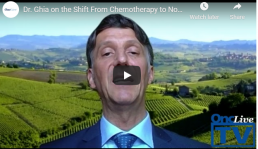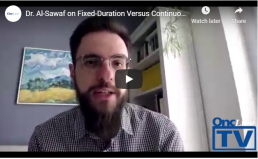Immunoglobulin Abnormalities Do Not Affect Overall Survival in CLL, Study Finds
Immunoglobulin Abnormalities Do Not Affect Overall Survival in CLL, Study Finds
This article was originally published by AJMC
Patients with chronic lymphocytic leukemia (CLL) who have immunoglobulin (Ig) abnormalities at diagnosis have shorter treatment-free survival (TFS) periods, but do not have shorter overall survival (OS), according to a new study.
The report, published in the British Journal of Hematology, sheds new light on the ways in which qualitative and quantitative gammaglobulin abnormalities affect—and do not affect—the prognosis of patients with MM.
A team of investigators, including corresponding author Luca Laurenti, MD, of Gemelli University Hospital, in Italy, noted that prior research has looked at the impact of hypogammaglobulinemia in patients with CLL. However, they said there is significant heterogeneity between cohorts, and much research has included both treated and untreated patients, making it difficult to examine the prognostic impact of such abnormalities.
In an effort to get a clearer picture of the impact, the investigators examined 1505 patients with CLL and split them into 4 cohorts based on the degree of Ig aberrations upon diagnosis. The vast majority (1083) had normal Ig levels, making up the largest of the 4 groups. The other 3 groups included 73 patients with IgM monoclonal gammopathy (IgM/CLL), 149 patients with IgG monoclonal gammopathy (IgG/CLL), and 200 patients with hypogammaglobulinemia (hypo-c).
“IgM paraprotein was significantly associated with a more advanced Binet/Rai stage and del(17p)/TP53 mutation, while IgG abnormalities correlated with a higher occurrence of trisomy 12,” the authors said.
Any type of Ig abnormality lowered a patient’s expected TFS, Laurenti and colleagues found, but there was not a corresponding statistically significant impact on OS.
The authors noted that hypogammaglobulinemia specifically has been linked in the past with higher infections and morbidity. Thus, Ig replacement therapy, which was not investigated in this study, is indicated by current guidelines for the management of patients with CLL.
“However, some studies suggest that hypogammaglobulinemia is not associated with a higher risk of death from infections, but rather with a shorter TFS and a higher risk of death from all causes, being primarily a marker of greater tumor burden and reflecting a more aggressive disease,” Laurenti and colleagues wrote.
This hypothesis is supported by the current study, they said.
More broadly, the authors said their 28% rate of Ig abnormalities fell somewhere in the middle of rates reported in existing research, which ranged from 7% to a high of 80%. The investigators also reported that the proportion of patients with each type of abnormality held generally steady across the 4 cancer centers in the study. However, the authors said the rates were somewhat of a surprise.
“Even though we did not perform any characterization of the heavy-chain isotype and considering that CLL cells express breakpoint cluster region proteins (BCRs) mostly of IgM and IgD isotypes, rather than the IgG class, IgM paraprotein was expected to be more frequent but instead the occurrence of IgG monoclonal component was even double than that of IgM,” the authors said.
In conclusion, the authors said while other factors such as IGHV status mutation, Binet/RAI stage, and del17p are known prognostic factors for OS, “Ig alteration does not have any impact on OS.”
Dr. Ghia on the Shift From Chemotherapy to Novel Agents in CLL
Dr. Ghia on the Shift From Chemotherapy to Novel Agents in CLL
This article was originally published by Onc Live
Paolo Ghia, MD, PhD, a professor of Medical Oncology and the director of the Strategic Research Program on CLL and the B Cell Neoplasia Unit at Vita-Salute San Raffaele University, discusses how use the of chemotherapy is decreasing in favor of novel agents in chronic lymphocytic leukemia (CLL).
Chemotherapy regimens and chemoimmunotherapy treatment approaches are fading out of the treatment algorithm of CLL, says Ghia. This shift will be seen in the updated ASCO guidelines, where chemoimmunotherapy only remains an option for patients who do not have access to the novel therapies that are currently available in some countries and regions.
Not everyone has the same accessibility, but for the patients who do, particularly in the first-line setting, most of them experience a benefit from novel therapies. Even in the relapsed/refractory setting, the percentage of patients who benefit from chemoimmunotherapy is reducing with time, concludes Ghia.
Tool appears to predict need for treatment in asymptomatic, early-stage CLL
Tool appears to predict need for treatment in asymptomatic, early-stage CLL
This article was originally published by Healio
A novel prognostic tool appeared to predict the need for treatment among patients with asymptomatic, early-stage, chronic lymphocytic leukemia, according to research published in Blood.
“CLL is an indolent disease that is treated only if symptomatic. Currently, between 70% and 80% of newly diagnosed [patients with CLL] are asymptomatic and therefore are offered a wait-and-see approach to management consisting of regular visits every 3 to 12 months. However, this approach is not easily accepted by patients, who often ask whether, when and how they will be treated,” Davide Rossi, MD, researcher at Oncology Institute of Southern Switzerland, told Healio. “So far, the eventual disease course cannot be predicted for patients after they have been offered wait and see, which in turn causes anxiety and uncertainty. Having a tool that accurately forecasts leukemia course will help patients in planning their life with the disease.”
Rossi and colleagues developed and tested the international prognostic score, IPS-E, to predict time to first treatment among 4,933 patients with early-stage, asymptomatic CLL included in 11 global cohort studies.
Among a training cohort of 333 patients, investigators observed three consistent and independent covariates that appeared associated with time to first treatment: unmutated IGHV genes, absolute lymphocyte count greater than 15 x 109/l and the presence of palpable lymph nodes. They used data from this cohort to develop a prognostic score with each factor counting as one point. Patients with zero factors were considered at low risk for requiring treatment within the first 5 years of diagnosis, those with one factor were considered at intermediate risk, and those with two or three factors were considered at high risk.
Investigators validated the score in nine cohorts staged by the Binet system and in one study staged by the Rai system. They observed C-index scores of 0.74 in the training series and 0.7 in the aggregate of validation series.
Overall, approximately 30% of patients were categorized as low risk, 35% as intermediate risk and 35% at high risk.
Moreover, meta-analysis of the cohorts showed 5-year cumulative risk for treatment initiation of 8.4% among patients considered low risk, 28.4% for those in the intermediate-risk group and 61.2% for those at high risk.

“In a time where the treatment paradigm of asymptomatic CLL may change if a survival benefit is proven by early intervention with novel agents, our international prognostic score could help in defining the early-stage population where treatment can be appropriate,” Rossi said. “Moreover, it could be helpful for the treating physician to better allocate medical resources, such as deciding on the interval between clinical assessments according to risk group. Health care professionals will be supported in the discussion while explaining CLL to patients — many of whom have never heard about the rare tumor. Physicians can also safely plan and advise in advance the proper timing of surveillance visits according to the predicted risk of leukemia progression.”
The international prognostic score warrants prospective evaluation, according to Rossi, and can be regarded as a building block on which newly discovered independent outcome predictors for patients with early-stage CLL could be added.
“In this sense, a prospective study could be designed to further assess and eventually strengthen this prognostic tool,” Rossi said.
For more information:
Davide Rossi, MD, can be reached at Oncology Institute of Southern Switzerland, Via Ospedale, 6500 Bellinzona, Switzerland; email: davide.rossi@eoc.ch.
CLL and MCL Survival Benefit From Umbralisib Plus Ibrutinib Holds Up in 4-Year Follow-Up
CLL and MCL Survival Benefit From Umbralisib Plus Ibrutinib Holds Up in 4-Year Follow-Up
This article was originally published by Targeted Oncology
Initial results for the combination of umbralisib plus ibrutinib (Imbruvica) showed high rates of response in early 2019, but longer-term follow-up presented during the 2020 European Hematology Association (EHA) Congress demonstrated that complete responses increased over time in patients with relapsed/refractory chronic lymphocytic leukemia (CLL) and mantle cell lymphoma (MCL).
For patients with MCL, the median progression-free survival (PFS) was around 11 months, and the overall survival (OS) was around 2.5 years, which is not much different than what has been observed with ibrutinib monotherapy. However, in the CLL cohort, the 4-year PFS rate was 80%, and the 4-year OS rate was 90%, which was a big difference compared with historical controls.
Many patients are still receiving treatment with ibrutinib and umbralisib on the study, but this dataset highlights the continued efficacy and safety of dual B-cell receptor blockade. Umbralisib remains an investigational agent at this time, but more positive findings for this agent were recently presented from the phase 3 UNITY-CLL trial, which evaluated umbralisib in combination with ublituximab (TGTX-1101) in patients with CLL.
In an interview with Targeted Oncology, Matthew Davids, MD, MMSc, an associate director with the Center for Chronic Lymphocytic Leukemia; director of clinical research, Lymphoma Program; and medical oncologist, Dana-Farber Cancer Institute and an assistant professor of medicine with Harvard Medical School, discussed the long-term follow-up results of ibrutinib in combination with umbralisib as treatment of patients with CLL and MCL.
TARGETED ONCOLOGY: For patients with CLL and MCL, could you discuss the prognosis we see in this relapsed/refractory patient population?
Davids: With the advent of the BTK inhibitor ibrutinib, the outlook for patients with relapsed/refractory CLL and MCL certainly improved quite a bit. The drug is very active, and yet, particularly for high-risk patients and for CLL that means, especially patients with TP53 dysfunction, the durability of these responses is usually relatively short, so in that CLL high-risk population, looking at median PFS of only about 2 to 3 years in the relapsed setting with ibrutinib as a monotherapy. In MCL, even though the response rates are high, actually, the PFS is only a little over one year with a bruit nib as a monotherapy. That provided a rationale to try to develop combination approaches for this population, and there’s a number of them that are being evaluated right now.
The 1 combination that we focused on was looking at dual blockade of the B-cell receptor pathway. We know that the CLL cells and MCL cells depend heavily on this B-cell receptor pathway for survival and that there’s actually another arm of the pathway that has Pi3K as a key node. We were really interested in going after this other arm of the pathway to see if we could try to prevent resistance to ibrutinib as a monotherapy agent. That was the rationale for the study design.
TARGETED ONCOLOGY: What were the methods of design used for this study, and what did the patient population look like?
Davids: One of the challenges with this study is that there was a previous study that combined a SICK inhibitor drug with a Pi3K inhibitor and showed significant toxicity. That was the first time that there was a dual targeting of the B-cell receptor pathway, so we decided to take a different approach and rather than targeting SICK to target BTK, and rather than using an older delta-specific inhibitor of Pi3K, we used a newer molecule called umbralisib, which is a selective Pi3K inhibitor. It also targets casein kinase 2.
The idea here was to use 2 very well-tolerated drugs to target these 2 different parts of the pathway and try to prove that this could be a safe and effective strategy. We were able to accrue 42 patients to the study, 21 with CLL and 21 with MCL. These were all relapsed/refractory patients, generally with at least 1 to 2 lines of prior therapy. Few of them had had prior ibrutinib as mono therapy, but they weren’t refractory to ibrutinib; they had maybe started it but were still in the first few months of treatment. It was a pretty high-risk population as well, about 70% of the CLL patients had the unmutated IGhV and about 20% of the CLL patients had deletion 17p or TP53 mutation. This is generally quite a high-risk population. Many of the MCL patients had also relapsed already after autologous stem cell transplantation and were in desperate need of effective treatment options.
TARGETED ONCOLOGY: What were the results from this study?
Davids: We had published the initial results of this study early last year with around 2 years of follow up, and we did find the high rates of response in both CLL and MCL. We saw very good tolerability. We were able to identify the recommended phase 2 dose of umbralisib drug as 800 mg in combination with standard dose ibrutinib. The challenge with that early report was that the follow up was quite short, and so really the idea with our update at the EHA meeting is now with around closer to 4 years of follow up, looking at the progression-free and open overall survival for these very high-risk patients.
The other thing that we looked at actually was the rates of complete remission, which did increase a bit over time as we’ve seen with B-cell receptor pathway inhibitors. That was the case in our study as well. What we thought were the key updates from this poster were the PFS and OS data. Now with MCL, these didn’t change too much. The median PFS was only around 11 months in this very high-risk population, although the median OS was about 2 and a half years. To us, this didn’t look too different from ibrutinib a monotherapy, so it was hard to know if there’s a difference there. Where we are really seeing a difference is with the CLL patients. Obviously, we’re comparing to historical controls. There’s no there’s no randomized comparator here, but we did see a 4-year PFS in this high-risk CLL population of close to 80% and a 4-year OS of 90% in the CLL population with many patients still on the to drug combination, doing very well. Our data set here really highlights both the efficacy and the safety of dual B-cell receptor blockade, and I think this really does warrant further study.
TARGETED ONCOLOGY: Now that we’ve seen these promising results in the relapsed/refractory setting, is their evidence you think just for moving this up in the treatment landscape or in another patient population?
Davids: I think 1 patient population where this could be a useful approach is in the post-venetoclax (Venclexta) setting. Particularly in CLL, now we’re using venetoclax in earlier lines of therapy, including in the frontline setting. This type of approach might be very useful to use, for example, in the second-line setting; I think that needs to be explored. I think there have been challenges with moving other Pi3K inhibitor drugs into the frontline setting. We’ve seen more immune-mediated toxicities in those studies, but I do think with umbralisib being a very well-tolerated Pi3K inhibitor drug and ibrutinib being such a popular regimen for frontline CLL, certainly this type of approach could be studied in the frontline setting prospectively.
TARGETED ONCOLOGY: How do you see this combination potentially impacting the treatment landscape for CLL and MCL?
Davids: As of right now, umbralisib remains an investigational agent, although we did recently hear a press release about a positive result in the CLL UNITY study. I think that this is a drug that’s headed toward a label in CLL and possibly in MCL as well. Although right now, this is not a regimen that could be utilized, I do think it’s potentially a regimen that could be utilized off label in the future for a select group of patients. However, I would feel more comfortable as there’s more data accumulating in larger datasets to make this as more of a recommendation for patients. I think we need larger studies and ideally, a randomized study where we can compare a doublet like this to perhaps singlet therapy with ibrutinib.
Nonetheless, I think our study is the first time that we’ve shown the feasibility of combining a BTK inhibitor with a Pi3K inhibitor. We showed it in these 2 non-Hodgkin lymphomas, but I think this is the type of approach that could also be studied in other non-Hodgkin lymphomas and may be promising there as well.
Dr. Al-Sawaf on Fixed-Duration Versus Continuous Treatment in CLL
Dr. Al-Sawaf on Fixed-Duration Versus Continuous Treatment in CLL
This article was originally published by OncLive
Othman Al-Sawaf, MD, discusses benefits of a fixed duration treatment versus continuous treatment in chronic lymphocytic leukemia.
Othman Al-Sawaf, MD, a physician with the University Hospital of Cologne in Germany, discusses benefits of a fixed duration treatment versus continuous treatment in chronic lymphocytic leukemia (CLL).
Traditionally, patients with CLL have been treated with fixed-duration treatments, says Al-Sawaf. When chemoimmunotherapy was administered to patients, they usually received 6 cycles of treatment. As such, for approximately 6 months, patients would have to regularly visit the hospital for surgery, chemoimmunotherapy, or antibody infusions. However, most of the novel compounds that are emerging have been developed for continuous treatment that the patient can receive orally and until disease progression or unacceptable toxicity.
Therefore, the field started to move away from fixed-duration approaches to more tolerable, but continuously administered drugs, adds Al-Sawaf. Now, however, there has been a shift back to examining whether these novel compounds can be administered as a fixed-duration rather than continuous treatment, concludes Al-Sawaf.




